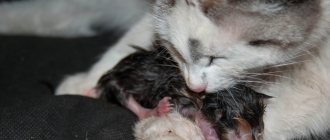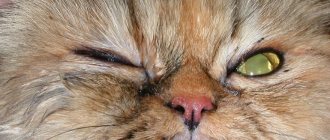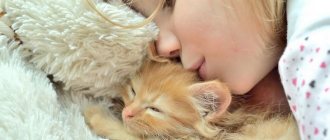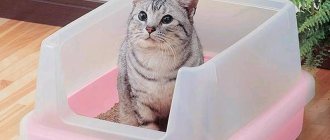(1 votes, rating: 1,00 out of 5)
5589564
08/04/2021 owner reviews
Most breeders cannot understand at the time of delivery of the pet whether the cat gave birth to all the kittens? This is necessary to avoid complications of subsequent pathological births. If the birth ends unsuccessfully, in this case the birth of all kittens, then this can lead to the death of the animal or a complete loss of reproductive function.
- How long does it take for a cat to give birth?
- How do I know when labor is over?
- Symptoms of unfinished business
- What we can do?
Can a cat not give birth to all kittens at once?
Usually, when a cat gives birth, kittens are born one at a time with an interval of 5-20 minutes.
The birth of kittens from a pet is an exciting and important event.
But due to the physiological characteristics of the animal, all the babies may not appear immediately, but after a certain time interval of several hours. Sometimes the pause lasts a day and a half, then contractions begin again, and one or two more cubs are born.
A break after the birth of a single kitten is a rare occurrence; this is a serious reason to be wary and carefully observe the behavior of the mother in labor.
The animal should be taken to a veterinary hospital if the following signs of complications appear:
- the cat does not show maternal care, is weakened, lies without changing position;
- attempts appear periodically;
- refuses to drink and eat;
- abdominal muscles are toned;
- Blood continues to leak from the vagina.
It happens that the fetuses die in the uterus, then a couple of days after birth the animal’s condition deteriorates sharply. The temperature rises, the animal experiences pain, and foul-smelling brownish-green discharge is observed from the vagina.
How long does it take for a cat to give birth?
The duration of work for representatives of the cat family depends on many individual factors. These include:
- physiological characteristics of a particular breed;
- How many times was lambing done?
- animal health;
- age of the cat;
- balance of hormones in the body;
- the conditions in which the animal is kept, its nutrition.
Most often, the normal birth of offspring in a cat lasts from 12 to 36 hours. Their duration takes into account the period of preparation, work and the birth of kittens. The kittens, in turn, come out into the world. The interval between their births can be from 30 minutes to an hour or more. There are situations where this may take several days.
© shutterstock
Cats have a physiological feature that, after the birth of a kitten, the contractions stop for a while, which allows the animal to recover and begin giving birth with renewed vigor.
How to understand how many kittens a cat has in the womb
It is impossible to visually determine how many embryos are in a cat’s belly, since the size of the abdomen is not considered an objective indicator. Its volume is affected not only by the number of fetuses, but also by amniotic fluid.
It is impossible to visually determine how many embryos are in a cat’s belly.
If the pet has one kitten in the womb, then the pregnancy may not be noticed at all.
Palpation shows the presence of fetuses in the uterus, but it is also impossible to give a specific number. In this case, intense palpation can harm the embryos and the normal course of pregnancy.
Ultrasound examination is considered a reliable diagnostic method. This is a safe way to determine the exact number of offspring. Carried out by a veterinarian in a veterinary clinic. The procedure is recommended if the cat has already had difficulties during childbirth.
Features of feline birth
Any cat owner should be aware of the nuances of their pet's reproduction and the stages of pregnancy. It is recommended to perform an ultrasound on the animal in time to ensure normal gestation and determine the number of kittens in the womb. You can find out about an approaching birth by the characteristic behavior of a cat: the expectant mother rushes around the apartment in search of a secluded place, licks her belly, and loses interest in food. Contractions begin after the mucous plug and amniotic fluid have drained. As a rule, kittens are not born immediately, but at intervals of 15-120 minutes. In some cases, the entire labor period lasts up to one and a half days. On average, a litter of a healthy and mature pet contains from 4 to 6 babies.
Yard cats, unlike their purebred counterparts, tend to be more fertile, and their births are easier. In addition, first-born cats are characterized by a small litter: no more than one or two kittens per litter.
It is advisable that a doctor be present at the first lambing of your pet.
It should be understood that during childbirth the animal is especially vulnerable, so it is necessary to notice the signs of an imminent birth in time and be close to the animal at the crucial moment. Usually a woman in labor copes with her task without any problems, but in some cases she cannot do without human help. It is recommended to take the first birth under the supervision of a veterinarian.
If the fetus is in the birth canal, what to do?
Sometimes the fetus gets stuck in the birth canal due to its large size or incorrect position, sometimes difficulties arise due to lack of lubrication or insufficient strength of uterine contractions.
In this case, there is a high risk of death for him and the kittens remaining in the uterus. If a situation arises, you must immediately call a veterinarian or take the cat to a veterinary hospital.
Attention! You should not try to help the cat yourself, especially if you do not have enough experience in obstetric care. It is strictly forbidden to pull the fetus by the limbs: unprofessional actions can lead to rupture of the vagina and kill the kitten.
Useful tips
Despite the fact that a half-hour birth interval in cats is considered the average norm, some deviations are allowed. Much depends on your health and age. In weakened or simply tired animals, this time may increase. If the animal behaves calmly, the owner should not be nervous either.
There are times when cats can drink water or even eat a little food between contractions, although most veterinarians do not recommend giving food while the birth process is underway. This can lead to complications such as volvulus and even more severe consequences. If you carefully palpate the cat's belly, you can feel the babies moving.
There are situations when you need to urgently call a veterinarian:
- the animal lies completely exhausted, from time to time meows loudly and protractedly. However, it should be remembered that in a pet giving birth for the first time, such behavior may be normal, so there is no need to panic ahead of time;
- the last cub appeared an hour ago;
- heavy bleeding;
- when palpating the abdomen, no signs of fetal activity are detected;
- the cat does not pay attention to newborns, does not tidy them up, and does not show any activity.
These signs may indicate the presence of serious pathologies: the death of one or more fetuses, their incorrect intrauterine position; possible injuries to the cat. In this case, the help of a veterinarian is necessary.
Source
Can a cat have one kitten?
Usually a cat gives birth to 3-6 or more kittens.
Usually a cat gives birth to 3-6 or more kittens, the birth of one kitten is also possible, this happens in the following cases:
- the animal is too young or the cat has reached old age and is finishing its reproductive functions;
- low quality of cat sperm due to illness or old age;
- genetic predisposition;
- death of embryos at an early stage;
- a disease of the reproductive system in a cat, which affects its fertility.
Be sure to read:
Miscarriage in a cat: symptoms, reasons, what to do, why kittens are born dead
There is a possibility of the birth of an only kitten, but the owner should not leave everything to chance. It is possible that problems arose during childbirth, so it is necessary to carefully monitor the pet.
If you suspect that the cat cannot give birth to the remaining kittens on her own, urgent measures must be taken.
Important! Sometimes the reason for the birth of a small number of offspring should be sought in the use of hormonal drugs that prevent conception. Stress caused by frequent use of hormones negatively affects the reproduction of animals, which affects the number of babies in the litter.
How does the first birth go?
A cat giving birth for the first time will behave restlessly. She does not understand what is happening, she may even be scared of her newborn offspring. Most often, pets give birth early in the morning or during the day. If the owner carefully monitors the animal, he will not miss the time of birth.
In three to four days, colostrum appears, and within a day the genitals will begin to enlarge. Pink or brown discharge may appear. Also, on the eve of birth, the pet’s behavior changes. To help her, you must first prepare the place for birth in advance so that she can get used to the new house. Place a bowl of water and food nearby. It is advisable that the tray also be placed closer (but at a distance from food and water). A week before the expected due date, it is advisable to take the animal to the veterinarian.
There is no need to be near the box all the time. After the birth of her first baby, mom will be busy. But it’s better not to go far, as in the process she may need human help.
It is advisable to have bowls of food and water near the cat.
What to do if the cat cannot give birth to the “last baby”?
When a cat has already given birth to several kittens, but there is a suspicion that not all the babies were born, urgent measures must be taken.
Attention! It is not advisable to independently check the presence of an unborn baby in a cat’s belly: it is unlikely that you will be able to feel the fetus with your fingers, but it is easy to harm it and the mother. Therefore, the only correct decision is to contact a specialist for an ultrasound.
In the absence of elevated temperature and spasms in the bronchi and heart rhythm disturbances, Oxytocin may be administered intramuscularly or into the withers to resume labor.
Sometimes the reason for the birth of small offspring should be sought in the use of hormonal drugs that prevent conception
The dosage depends on the weight of the animal, no more than 0.2-0.3 ml. If the medicine does not work, repeat the procedure after 20 minutes. If there is no result, a caesarean section can save the situation.
Important! The drug is not used if the birth canal is blocked by the fetus. The use of stimulants accelerates the separation of the placenta, which can lead to the death of the kitten and causes uterine rupture.
What not to do during childbirth
In the desire to help a giving birth cat, it is important not to harm. There are a number of actions that are prohibited. What you shouldn't do:
- do not press on the stomach, this will cause pain to the cat and harm the kittens inside;
- do not pull the umbilical cord so that it does not break or cause a hernia in the cat;
- do not burst the bladder if the woman in labor is ready to do it herself;
- Do not give injections without your veterinarian's approval and do not use medications to induce normal labor.
- do not use instruments without sterilization to avoid infection;
- Do not take kittens away from your cat immediately after birth.
Is there a chance to save a kitten during a caesarean section?
The doctor cannot guarantee that unborn kittens can be saved by caesarean section. Since it is possible that the fetuses died due to hypoxia due to their prolonged stay in the uterus. The operation is more necessary for the cat itself to save its life.
Sometimes surgical intervention cannot be performed urgently due to contraindications. This is due to the fact that the operation requires stable operation of all body systems, but if the animal has a violation of cardiac and respiratory functions, it may not withstand the load and die.
Be sure to read:
Pregnancy of a Scottish Fold cat: how long they walk, behavior, what to feed, childbirth
If the kittens suffocated in the womb, and the decomposition process has already begun, performing a cesarean section is pointless, since necrotic changes spread to the uterine cavity.
This requires surgery to remove the organ and ovaries, since there is a high risk of developing septic complications and death.
How to care for a cat after giving birth
Caring for your pet should begin even before labor begins in order to prepare for the crucial moment, which can begin at any moment. You also need to continue to pay attention after the end of labor.
- It is absolutely necessary in advance, even before the birth, to equip a place for childbirth and show these places to the woman in labor. Prepare a box or build some kind of house. In some cases, the cat may ignore these signals and find secret places on its own. If this happens, carefully move it to the prepared place.
- Place a snack and water nearby so that if she is thirsty or hungry, she can easily reach the food.
- Be sure to place the toilet nearby so that the mother can be close to her offspring and keep an eye on them.
- Don't hide kittens from their mother. When children are not in her field of vision, she begins to get nervous, and if she sees that a person poses a threat, she may change in behavior.
- Children and guests do not need to touch newborns; let only one person do this so that the pet can trust her offspring.
- Provide dim lighting, warmth, soft blankets and bedding. Bright light will have an adverse effect on the eyes of mole rats.
- Prepare diapers and towels to ensure hygiene. Usually they themselves lick off the remains of food after labor, but some tailed animals may not be able to do this. Inspect the genitals and wash them with damp cloths. Change the diaper when it gets dirty.
- There is no need to put your cat on a diet after giving birth; on the contrary, give her as much food as she requires. This is necessary for her body to provide food for small children.
- If the tailed one loved to walk outside before giving birth, now you can forget about it. While the kittens are small and fragile, it is worth prohibiting walks, even if she really wants it. During her walks, she picks up a lot of bacteria, which she can then pass on to her children, and their bodies are still very weak to bear it. Also, prohibitions on walking will protect against the next birth, because estrus may start again, and under no circumstances should you become pregnant so quickly.
- Monitor the body's behavior: check the temperature, monitor postpartum discharge, nipple discharge.
- Small children should not be allowed out into open areas, onto the floor or onto sofas. The mother will not approve of this, but there will be danger: falling or catching a cold.
Watch the offspring and mother at this happy moment. If the health of the mother or babies becomes suspicious, contact your veterinarian. The cat must be as healthy and happy as possible, and the kittens must grow up strong.
The birth of a new life is a great process given to us by nature and such an event is especially valuable for a cat.
Signs of the end of labor
The end of labor in a cat can be understood by the following signs:
- breathing becomes smooth and calm;
- heart rate becomes stable;
- the pet begins to actively lick the kittens, lie on its side so that it is easier for them to reach the nipples, and purrs;
- the animal needs water and food;
- an hour after the birth of the last kitten, muscle tension goes away and the belly becomes soft.
The cat leaves the nest for a short time to eat.
What signs should you look out for?
When it comes to the fact that a cat may not give birth to all kittens, then this situation poses a danger to the pet, even to the point of death.
A fetus that is not born will eventually begin to decompose in the womb, releasing toxic substances that are harmful to the animal. How to determine if everything is okay and what help to provide to your pet? The birth is not considered complete if:
- the cat after giving birth is not interested in kittens and does not lick them;
- refuses food and water;
- a day later, the cat’s temperature rose to 39 degrees or higher;
- when the fetus appears, the cat does not change position and continues to periodically push;
- the abdomen is hard and tense on palpation, the fetus can be felt;
- after 2 days, urine and feces are colored scarlet, and an unpleasant odor emanates from the pot.
The birth process in a cat occurs in 3 stages. First, the cat begins to moan and meow, the cervix opens, and the birth plug with discharge comes out. In the second phase, contractions become intense, the cat tenses, and kittens begin to emerge through the birth canal.
It happens that a cat runs away in fright or gets lost during the first lambing; in this case, it is important to re-examine the kittens and, if necessary, cut the bladder with sterile scissors so that the cub does not suffocate. At the final stage, the placenta is separated; it is important to ensure that the cat does not eat the afterbirth or the stillborn (weak) kitten
If all the rules are followed, but there are still concerns that the cat has not completely given birth, it is important to contact a veterinarian for help.
At the final stage, the placenta is separated; it is important to ensure that the cat does not eat the afterbirth or the stillborn (weak) kitten. If all the rules are followed, but there are still concerns that the cat has not completely given birth, it is important to contact a veterinarian for help.
Veterinarians' Answers to Common Questions
A cat leaves the nest for a short time to eat
For cat owners who have not yet experienced the birth of an animal, the birth of kittens from a pet is a serious cause for concern.
After all, they do not know about the peculiarities of the course of childbirth and preparation for a responsible process. Veterinarians provide advice and answer common questions from new breeders.
How to prepare for the birth of a cat?
In order for your pet to give birth normally, it is important to provide the animal with optimal living conditions and adequate nutrition during pregnancy.
10-14 days before giving birth, you need to prepare a nest for the pet where the animal will give birth. Usually this is a box or a spacious basket, where the cat will feel comfortable and safe. The bottom is lined with several layers of flannel or fleece fabric, which you don’t mind throwing away later. You need to accustom your cat to the place in advance, otherwise she will choose a secluded corner for herself.
When the time comes for the birth of offspring, despite the fact that in 99% of cases everything goes well, it is necessary to prepare for the process a week before the expected due date. This is especially important if the cat gives birth for the first time.
What items are needed:
- clean cotton cloth and napkins;
- syringes and petroleum jelly;
- antiseptic solution (regular iodine will do);
- silk thread;
- tweezers and nail scissors;
- latex gloves;
- bandage or gauze.
Medical supplies will be needed if the cat is unable to chew the umbilical cord on its own or if it needs to be delivered.
Advice! It is recommended to stock up on the phone number of a veterinarian, who is available 24 hours a day, and a notepad to document the time of birth of the babies and the expulsion of the placentas. The data will be important if specialist help is needed.
Features of childbirth in a cat: how kittens are born
The duration of labor and the peculiarities of its course in cats are determined by the following factors:
- age;
- breed;
- state of health and hormonal system;
- conditions of keeping and nutrition of a pregnant animal.
You can determine the approach of childbirth by the behavior of your pet: she licks herself more often, hides in dark corners. Sometimes it relentlessly follows the owner, caresses him, demanding attention, or shows displeasure if he wants to pet her. Pinkish discharge is noticeable from the birth canal.
Be sure to read:
Pregnant Sphynx cat: how to find out about the position, changes in behavior and appearance, how long they walk
If a cat gives birth for the first time, and instinct does not “tell” her an algorithm of actions, the owner will have to help the kitten himself
Kittens appear after the start of pushing, move forward with their heads, sometimes with their hind legs. The fetus is enveloped by an amniotic sac, and sometimes it ruptures as it passes through the birth canal. The caring female herself frees the cub from the film and bites the umbilical cord.
Important! If a cat gives birth for the first time, and instinct does not “tell” her an algorithm of actions, the owner will have to help the kitten himself. Internet users can watch the process of cutting the umbilical cord on video.
How many times a year does a cat get pregnant?
Due to physiological characteristics, an adult cat is capable of becoming pregnant 3, even 4 times in a year, but this rate depletes the animal’s body and leads to pathological metabolic processes and changes in internal organs.
It takes 8-14 months for an animal to fully recover after childbirth and feed its offspring. Therefore, the optimal number of pregnancies per year is 1, maximum 2 times.
How long does this physiological process last?
The average duration of pregnancy is 57-71 days after mating. Childbirth occurs earlier in short-haired breeds and with multiple offspring.
Interesting! Representatives of the Scottish breed carry fetuses on average for up to 71 days, hairless sphinxes - 63, English cats - 65, large Maine Coons often live up to 68 days.
Until what age can cats give birth?
Cats are capable of giving birth before the end of estrus; for them it lasts up to 18, less often up to 20 years, but stray animals rarely live to this age.
In addition, the duration of the functions of the reproductive system after 10 years does not ensure the appearance of healthy offspring. Therefore, in older animals, the risk of giving birth to weakened kittens and with pathologies of intrauterine development increases.
Features of childbirth
Childbirth in cats is an individual process. Their duration depends on various factors:
- age;
- physiological state;
- number of births;
- animal breeds;
- living conditions and diet during pregnancy;
- hormonal status of the body;
- individual characteristics, etc.
On average, labor in cats lasts 12-36 hours. This time includes the preparatory period with contractions and pushing. It can last several hours or several days. Then labor begins. Kittens appear one by one. As a rule, between thirty minutes and several hours can pass between the birth of two kittens. But there are times when childbirth lasts a day or even several.
A cat needs human support during birth
There are no specific norms for cat labor. You need to proceed from your own experience and conditionally defined time frames. Contractions on average begin 10–12 hours before the onset of labor. The first contractions are the weakest. The break between them can be 30–40 minutes. During this period, the expectant mother can remain active, drink and eat. A characteristic sign that she is going into labor is that she stops sleeping. In the second stage, the body produces stimulating hormones that keep it awake.
The interval between the strongest contractions is 30–40 seconds. This indicates that the first kitten is already at the birth canal, and there is little time left before pushing. The norm is 2-3 attempts, then a kitten appears. After the first, the amniotic sac containing amniotic fluid comes out. They either burst on their own or are opened by a cat. Then one or two more attempts follow, after which the baby appears. Mom licks him, gnaws the umbilical cord and eats the afterbirth.
Normal time between kittens being born
The average time between the first contractions and the appearance of the offspring is approximately 12 hours. If more time has passed and the kittens do not appear, the help of a veterinarian is needed. If labor remains inactive for a long time, hypoxia may develop - oxygen starvation of the fetus. This can adversely affect the health of the offspring or be fatal.
The average duration of all stages is approximately 24 hours. Their duration is influenced by the number of kittens, the general health of the mother, and external factors. When a cat gives birth, the interval between the appearance of kittens is 15-30 minutes, sometimes it can increase to one hour. All this time, contractions will be repeated between attempts. The intervals between kittens during birth are usually the same.
The interval between the appearance of kittens makes it possible to get the babies in order
The cat gives birth too quickly
Childbirth is sometimes rapid: in this case, kittens come out very quickly. This deviation is considered the most dangerous compared to protracted labor. In the case of rapid labor, all offspring are born in just an hour. This can happen due to stress or miscarriage. Sometimes this can be hereditary. In such a situation, the cat experiences very strong pain due to the short intervals between contractions.
In this case, kittens are born almost without interruption; the cat does not have time or cannot properly lick the cubs or gnaw the umbilical cords, but can eat the placenta or even the kittens. This suggests that either the offspring are not viable, or a miscarriage has occurred.
In case of rapid birth, the kittens will have to be looked after by the owner
During rapid labor, human help is needed: to open the blisters as quickly as possible, clear the airways of fluid and mucus, and wipe the babies.
After this, you need to give the mother a little time so that she can calm down and try to attach the kittens to her nipples. Some cats calmly begin to feed. But there is a possibility that the pet will begin to hiss and growl at the kids. In this case, they will have to be fed by the owner, but they have very little chance of surviving on artificial feeding.
The cat is giving birth for too long
An inexperienced owner cannot always determine whether the birth process is normal. Therefore, it is important to know at what interval a cat gives birth to kittens. Labor is considered protracted and the cat needs help if:
- contractions started 12 hours ago, and the first baby has not yet appeared;
- the birth bubble appears, but there is no effort for 10-15 minutes;
- The first kitten was born more than an hour ago, and the next attempts have not begun.
After the babies appear, the cat licks the kittens and eats the afterbirth.
If the birth is protracted, the pet has more opportunities to save the life of her offspring. The owner must monitor how long it takes for the cat to give birth to the next kittens. Sometimes labor stops: not all babies have been born yet, but labor has stopped. This condition can persist for 36 hours. The animal’s behavior can be quite normal: eating, sleeping and other usual actions. When the body is ready, the birth process will begin again.
But such situations are rare. Most often this is associated with a loss of strength and indicates a forced cessation of the birth process. As a result, the fetus remaining inside dies, and toxins begin to enter the body. The same can happen if there are afterbirths inside.











